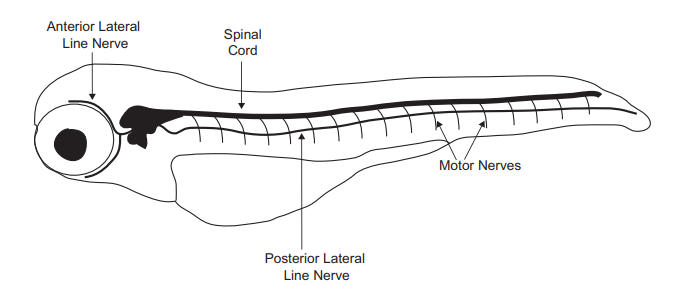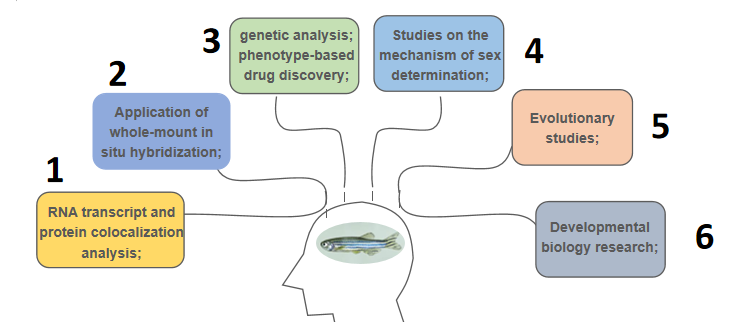Creative Bioarray provides comprehensive FISH technology services for the model organism zebrafish for analysis of chromosome mapping and gene expression in cytogenetics, evolution, cancer mechanisms, and other related studies using zebrafish. With various FISH solutions and complete equipment platforms, we provide customers with high-quality data and images.
Zebrafish Models and Genetic Analysis
The zebrafish has emerged as a prominent vertebrate disease model, has been used to study carcinogenesis, and has contributed to several examples of successful phenotype-based drug discovery. Recent studies have begun to identify the capabilities and limitations of zebrafish in disease modeling, drug screening, target identification, pharmacology, and toxicology. Cytogenetic characterization of the genome is critical for deepening our understanding of disease progression. With the deepening of zebrafish understanding and the advancement of related genetic manipulation techniques, zebrafish models are of great significance in accelerating precision medicine research. Additionally, the zebrafish embryo has become a popular model for studying developmental biology due to its features such as extrauterine embryogenesis and optical transparency. To make zebrafish more widely available for drug development and developmental biology research, key hurdles must be overcome including a more comprehensive elucidation of the similarities and differences between human and zebrafish biology. Cytogenetic methods based on metaphase chromosomes established from dividing cells allow direct microscopy of individual chromosomes, a powerful technique for studying aneuploidy, chromosomal aberrations, and genomic instability. Several well-established methods have been developed to improve accuracy in zebrafish visualization analysis schemes.
 Fig 1. Schematic of a zebrafish larva. (Rebecca L. Cunningham, et al. 2018)
Fig 1. Schematic of a zebrafish larva. (Rebecca L. Cunningham, et al. 2018)
FISH Solutions in Drosophila Mitosis
Molecular cytogenetic analysis using FISH methods has been applied in various studies to further characterize the cytogenetics of the zebrafish genome. We offer FISH visualization methods for various studies using zebrafish. These studies include zebrafish-based target sequence copy number analysis and chromosome mapping, evolutionary studies, establishing a basic description of the zebrafish chromosomal karyotype, and cytogenetic characterization of each specific chromosomal marker. Our FISH services can be performed on metaphase chromosomes or chromatin fibers. Fiber-FISH and metaphase FISH methods have good resolution and allow for more detailed characterization of cytogenetic abnormalities, including efficient and accurate identification of DNA copy number changes in specific chromosomal regions. At the same time, the combination protocol of whole-mount fluorescence in situ hybridization (FISH) and whole-mount immunofluorescence (IF) that has emerged in recent years can be used for the co-localization of RNA transcripts and proteins. Our FISH technology platform also provides solutions for co-localized expression analysis of RNA transcripts and proteins. Sample types that our platform can serve include typical FFPE samples, cultured cells, and zebrafish embryos. Our technical support starts with sampling and sample preservation.
Application
Gene expression analysis, spatial expression analysis of mRNA;
RNA transcript and protein colocalization analysis;
Application of whole-mount in situ hybridization technology in zebrafish genetic analysis;
phenotype-based drug discovery;
Studies on the mechanism of sex determination (SD) in zebrafish;
Evolutionary studies based on zebrafish models;
Developmental biology research based on zebrafish model;
 Fig 2. Availability of FISH assays in zebrafish.
Fig 2. Availability of FISH assays in zebrafish.
If you are interested in our service, please contact us for cooperation. We look forward to cooperating with you in the near future.
Reference
- Cunningham, Rebecca L., and Kelly R. Monk. "Whole mount in situ hybridization and immunohistochemistry for zebrafish larvae." Schwann Cells. Humana Press, New York, NY, 2018. 371-384.


 Fig 1. Schematic of a zebrafish larva. (Rebecca L. Cunningham, et al. 2018)
Fig 1. Schematic of a zebrafish larva. (Rebecca L. Cunningham, et al. 2018) Fig 2. Availability of FISH assays in zebrafish.
Fig 2. Availability of FISH assays in zebrafish.


